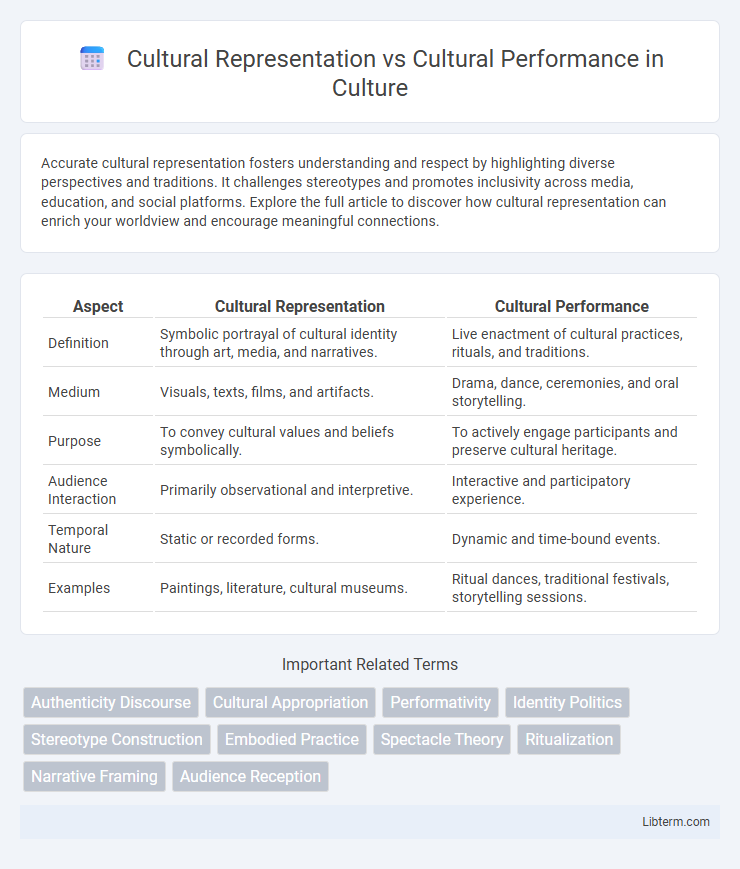Accurate cultural representation fosters understanding and respect by highlighting diverse perspectives and traditions. It challenges stereotypes and promotes inclusivity across media, education, and social platforms. Explore the full article to discover how cultural representation can enrich your worldview and encourage meaningful connections.
Table of Comparison
| Aspect | Cultural Representation | Cultural Performance |
|---|---|---|
| Definition | Symbolic portrayal of cultural identity through art, media, and narratives. | Live enactment of cultural practices, rituals, and traditions. |
| Medium | Visuals, texts, films, and artifacts. | Drama, dance, ceremonies, and oral storytelling. |
| Purpose | To convey cultural values and beliefs symbolically. | To actively engage participants and preserve cultural heritage. |
| Audience Interaction | Primarily observational and interpretive. | Interactive and participatory experience. |
| Temporal Nature | Static or recorded forms. | Dynamic and time-bound events. |
| Examples | Paintings, literature, cultural museums. | Ritual dances, traditional festivals, storytelling sessions. |
Understanding Cultural Representation
Cultural representation involves the depiction and communication of a group's identity, values, and traditions through symbols, language, art, and media. Understanding cultural representation helps reveal power dynamics and the authenticity or stereotyping present in portraying cultures. It plays a crucial role in shaping perceptions and preserving cultural heritage across societies.
Defining Cultural Performance
Cultural performance refers to the dynamic enactment of cultural practices, rituals, and expressions that bring collective identities to life through behavior, storytelling, and symbolic acts. It emphasizes the participatory and performative aspects of culture, highlighting how meaning is created and communicated in social contexts rather than static representation. Understanding cultural performance involves analyzing the interactions, gestures, and narratives that constitute lived experiences within specific cultural frameworks.
Key Differences Between Representation and Performance
Cultural representation involves the portrayal or depiction of a culture's symbols, values, and traditions through media, art, or narrative, serving as a static or interpretive reflection. In contrast, cultural performance encompasses the active, dynamic enactment of cultural practices, rituals, or expressions in real-time social contexts, emphasizing participation and embodiment. Key differences include representation as a mediated or reproduced image, whereas performance is an experiential, ephemeral event grounded in communal interaction and lived experience.
Historical Contexts of Cultural Expression
Historical contexts of cultural expression reveal significant differences between cultural representation and cultural performance, where representation often involves static depictions tied to identity and heritage, while performance emphasizes dynamic enactments reflecting lived experiences and social changes. Cultural representation in art, literature, and media frequently preserves historical narratives and collective memory, serving as a site of cultural preservation and political assertion. In contrast, cultural performance, including rituals, theater, and festivals, actively engages participants and audiences in reinterpreting tradition, adapting to historical shifts and contemporary realities.
The Role of Media in Shaping Perceptions
Media plays a crucial role in shaping perceptions by selectively representing cultural identities, often reinforcing stereotypes or simplifying complex traditions into digestible performances. These portrayals influence public understanding by framing culture not only as static heritage but also as dynamic performances tailored for audience consumption. The distinction between cultural representation and cultural performance becomes blurred as media transforms authentic practices into commodified narratives, impacting societal attitudes and cross-cultural relations.
Authenticity vs. Appropriation in Culture
Cultural representation involves depicting cultural elements in a way that respects their historical context and significance, ensuring authenticity and honoring the source community's identity. Cultural performance, on the other hand, emphasizes the enactment or expression of culture, which risks appropriation when elements are used without understanding or permission, leading to misrepresentation or commodification. Maintaining authenticity requires active engagement with and consent from cultural insiders, distinguishing respectful practices from exploitative appropriation.
Impact on Identity and Community Narratives
Cultural representation shapes identity by providing symbols and narratives that communities use to understand and express their heritage, reinforcing collective memory and social cohesion. Cultural performance, through rituals, ceremonies, and artistic expressions, actively enacts and negotiates identity, allowing communities to live and transform their traditions in dynamic ways. Both processes influence community narratives by either preserving static images or fostering evolving interpretations, impacting how identity is perceived internally and externally.
Globalization and the Evolution of Cultural Practices
Globalization accelerates the exchange of cultural symbols, challenging traditional boundaries between cultural representation and cultural performance. Cultural representation often encapsulates static images or narratives that may become commodified, while cultural performance embodies dynamic, lived experiences that evolve through global interactions. This ongoing evolution highlights the fluidity of cultural practices as communities adapt to transnational influences, reshaping identities in a globalized world.
Challenges in Accurately Portraying Cultures
Accurately portraying cultures involves navigating the complex challenges of avoiding stereotypes and ensuring authentic representation without oversimplification. Cultural representation often risks reducing diverse traditions to static symbols, while cultural performance demands dynamic engagement with living practices that may evolve over time. This dichotomy creates tension between preserving cultural integrity and adapting portrayals for contemporary audiences, complicating efforts to depict cultures honestly and respectfully.
Towards Ethical Engagement with Cultural Traditions
Cultural representation involves the accurate and respectful portrayal of traditions, symbols, and practices to honor their original meaning and context, fostering understanding and appreciation. Cultural performance, by contrast, focuses on the enactment or display of these traditions, which may risk commodification or misinterpretation if detached from their cultural significance. Ethical engagement requires prioritizing informed consent, community collaboration, and ongoing dialogue to ensure authenticity and respect in sharing cultural heritage.
Cultural Representation Infographic

 libterm.com
libterm.com